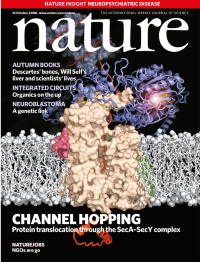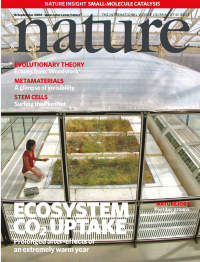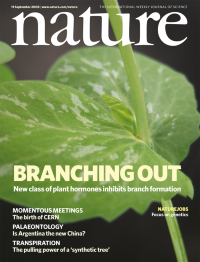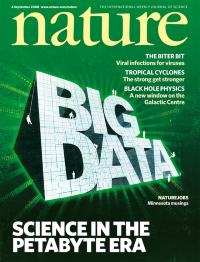Volume 455
-
No. 7217 30 October 2008
Sands of time: Traces of recurring tsunamis on Indian Ocean shores Nothing known from written history gave reason to expect the Indian Ocean tsunami that took nearly a quarter million lives on 26 December 2004. That tsunami entered geological history by laying down centimetres of sand on the coastal plains that it overran. Jankaew et al. have now found such sedimentary records of earlier tsunamis preserved in the dark soils of marshy swales at Phra Thong, a barrier island in western Thailand. The cover shows an example from a pit dug there in 2007: the topmost light-coloured layer represents the 2004 tsunami, while a similar layer below records a tsunami in the fourteenth or fifteenth century AD. The ruler divisions are 10 cm long. In a separate study in Aceh, Indonesia, Monecke et al. found the 2004 sand sheet preceded by the deposits of three tsunamis from the past 1,200 years. One of these earlier deposits may match the medieval one found in Thailand. The combined findings suggest that the 2004 tsunami is neither the first nor the last of its kind.
-
No. 7216 23 October 2008
Triboluminescence is an optical phenomenon sometimes seen when there is relative motion between two contacting surfaces. Everyday examples include sugar cubes or candies that are rubbed together, and many adhesive tapes will emit a flash of light when they are ripped from a surface. Physicists from the University of California at Los Angeles set out to characterize sticky tape triboluminescence, with surprising results. The energy released by peeling sticky tape in a vacuum was observed to extend into the X-ray regime, and was of sufficient intensity to be used for X-ray photography. The cover picture shows the X-ray image of a human finger taken with peeling tape (off-the-shelf Scotch tape was used) as the X-ray source. The developed X-ray is superimposed over a view of the experimental set-up. The energy concentrating process at work here poses an interesting challenge for the theorists, since the limits on energies and flash widths involved are beyond the predictions of current theories.
-
No. 7215 16 October 2008
Channel hopping: protein translocation through the SecAâSecY complex Newly synthesized proteins are translocated across the eukaryotic endoplasmic reticulum membrane or the prokaryotic plasma membrane through an evolutionarily conserved protein conducting channel or translocon known as Sec61 in eukaryotes and SecY in prokaryotes. In bacteria, the SecA ATPase is thought to be the motor for translocation through the SecY channel. Two papers by Tom Rapoport and colleagues report the long-awaited structure of the SecAâSecY complex from bacteria. The structure, shown on the cover of this issuue, reveals major conformational changes between both partners and suggests that SecA uses a two-helix finger to push translocating proteins into SecYâs cytoplasmic funnel. Crosslinking studies provide further experimental support for this mechanism. In a third paper, Osamu Nureki and colleagues present a crystal structure of SecY bound to an anti-SecY Fab fragment revealing a pre-open state of the channel. Together these three papers provide novel insights into the path taken by a translocating protein. In News and Views, Anastassios Economou takes stock of where this work leaves current knowledge of this âastonishing cellular nanomachineâ. [Article p. 936; Letters pp. 984, 988; News & Views p. 879]
Insight
-
No. 7214 9 October 2008
New Plasmodium sequences kick-start comparative genomics Four distinct Plasmodium species are known to regularly infect humans: Plasmodium falciparum, P. vivax, P. malariae and P. ovale. The genome sequence of P. falciparum, the cause of the most severe type of human malaria, was completed in 2002 at the same time as the mosquito vector, Anopheles gambiae. In this week's Nature, which focuses on the malaria parasite, two further malaria genome sequences are described. First that of P. vivax, which contributes significant numbers to malaria incidence in humans, though in contrast to P. falciparum, the resulting disease is usually not fatal. The genome of this rather neglected species is presented together with a comparative analysis with the genomes of other Plasmodium species. The micrograph on the cover (by Elisabet Caler & Jane Carlton) shows an infected liver cell containing P. vivax in the dormant hypnozoite stage. [Article p. 757] Second, we publish the genome sequence of Plasmodium knowlesi. For long regarded as a monkey malaria parasite, it is increasingly becoming recognized as the fifth human-infecting Plasmodium species. In particular, it is prevalent in South East Asia where it is often misdiagnosed as another human malaria parasite P. malariae. As a model organism P. knowlesi stands out: not only is it a primate system, useful for work on vaccines, but it can be cultured in vitro and subjected to efficient transfection and gene knockouts. [Letter p. 799]. In a Review Article, Elizabeth Winzeler considers the progress made towards using the genome sequence to understand basic malaria parasite biology, and in particular the work on developing rational therapeutic approaches to combat P. falciparum infections. [Review Article p. 751]. See also the Editorial [page 707]. For a comprehensive collection of resources visit Nature's past malaria specials online. [http://tinyurl.com/4x95hm; http://tinyurl.com/3n78pn; http://tinyurl.com/3ozy38; http://tinyurl.com/4kv6sx; http://tinyurl.com/5442hp; http://tinyurl.com/42w2a7t]
-
No. 7213 2 October 2008
Speciation in colour: a textbook example of evolution in action The cichlid fish of African lakes are textbook examples of rapid speciation but the mechanisms involved remain elusive. Observations of the cichlids in Lake Victoria now demonstrate the ecological and molecular basis of divergent evolution of the visual system (seen as divergence of vision genes, male coloration and female preferences) leading to speciation by sensory drive through interacting natural and sexual selection. The sensory drive hypothesis predicts that divergent adaptation in sensory and signalling systems to different environments can cause premating isolation between populations. As well as providing clear evidence that speciation can occur through sensory drive without geographical isolation, this work provides a mechanistic explanation for the collapse of cichlid fish species diversity during the anthropogenic eutrophication of Lake Victoria. On the cover, the colourful cichlids Pundamilia nyererei and Pundamilia pundamilia, as well as a wild intermediate (top) with the light spectra from different water depths in the background. [Article p. 620; News & Views p. 601; www.nature.com/podcast] Cover images: Ole Seehausen & Inke van der Sluijs.
-
No. 7212 25 September 2008
Choosing a future: Why science matters This week's US election special begins with a look at what's at stake in this campaign and beyond for science. We ask how the candidates have developed their stances on science over time, who is advising them, and where they might take the country [page 442]. The parties' stances on science and technology matters are summarized [page 446], and we ponder the prospects of key science agencies such as NASA, EPA and NIH, under a McCain or Obama administration [page 451]. David Goldston adds a personal viewpoint from Washington D.C. [Party of One p. 453] See also the introductory editorial [page 431], advice to a potential president on what books to read [Books & Arts p. 464] and the expanded on-line elections special on www.nature.com/uselection. Listen also to the series of election podcasts, on www.nature.com/nature/podcast. Images: Xinhua News Agency/eyevine & Sipa Press/Rex Features
-
No. 7211 18 September 2008
Ecosystem CO2 uptake: Prolonged after-effects of an extremely warm year. Earth's terrestrial ecosystems strongly modulate levels of CO2 in the atmosphere through seasonal changes in net plant productivity (CO2 absorbance) and soil microbial respiration (CO2 release). It has been known for decades that these processes respond to seasonal shifts in climate, especially temperature, resulting in the zig-zag form of the global CO2 curve, but the data necessary to quantify impacts of a single climate variable at interannual timescales have been lacking. A four-year study using intact tallgrass prairie ecosystems in controlled environment chambers (like the one on the cover, showing plant communities a few weeks after summer mowing) now provides some of the missing data. The results show that one anomalously warm year reduces net ecosystem CO2 exchange for that year and the year after. Carbon sequestration in ecosystems exposed to high temperatures for a year is a third of that in controls. These findings suggest that more frequent anomalously warm years, a possible consequence of rising anthropogenic CO2 levels, could lead to a sustained decrease in CO2 uptake by terrestrial ecosystems. Cover photo: J. Arnone [Letter p. 383; www.nature.com/podcast]
Insight
-
No. 7210 11 September 2008
Branching out: new class of plant hormones inhibits branch formation For many years the textbooks recognized five classic plant hormones: auxin, gibberellins, ethylene, cytokinin and abscisic acid. To these can be added the brassinosteroids, nitric oxide and jasmonates, among others, as phytohormones or plant growth regulators. Shoot branching is regulated by hormones, with both auxin and cytokinin playing a part. But the existence of mutants with enhanced branching in several species suggested a third factor was involved, a novel plant hormone released from the roots that prevents excessive shoot branching. Two groups now identify a class of chemical compounds called strigolactones or one of their derivatives as that missing hormone. Strigolactones are found in root exudates and are reduced in the branching mutants; external application of these chemicals inhibits shoot branching in the mutants. On the cover, a growing bud in the leaf axil of an increased branching mutant of pea (Pisum sativum). [Articles pp. 189, 195; News & Views p. 176] Cover photo: Elizabeth Dun.
-
No. 7209 4 September 2008
In Nature this week, features and opinion pieces on one of the most daunting challenges facing modern science: how to cope with the flood of data now being generated. [Editorial/Introduction p. 1] A petabyte is a lot of memory, however you say it - a quadrillion, 1015, or tens of thousands of trillions of bytes. But that is the currency of 'big data'. We visited the Sanger Institute's supercomputing centre, and its petabyte of capacity. [News Feature p. 16] Wikipedia's success shows how well the 'wiki' concept of open-access editing can work. It could work too as a way of coping with the data flows of modern biology. [News Feature p. 22] The worlds leading search engine is ten this month. Eleven years ago few would have predicted Googles domination: undaunted we ask scientists and business people to try to predict the next big thing, a Google for the petabyte era. [Special Report p. 8] Digital data are easily shared, and just as easily wiped or lost. The problem of keeping on-line data accessible is especially difficult for the smaller lab. [Commentary p. 28] In Books & Arts, Felice Frankel and Rosalind Reid champion the cause of data visualization as a way of finding meaning in an otherwise daunting data stream. [Books & Arts p. 30] From the 1700s to the mid 1950s, most 'computers' were human. Best known were the 'Harvard computers', a group of women working from the 1880s until the 1940s, at the Harvard College Observatory. Employed to classify stars captured on millions of photographic plates, some of the computers made significant contributions to science. [Essay p. 36] Online databases are a vital outlet for publishing the data being produced by biological research. But the data need to be properly organized. This is the role of the biocurator, but as a team of authors from 15 of the worlds major online research resources explains, biocuration is now sadly neglected. [Feature p. 47] An aspect of the data boom with a political dimension is the environment: how much data to collect, how much money to spend. [Party of One p. 15] For 'Big data' online, go to www.nature.com/news/specials/bigdata/ and to www.nature.com/podcast. [Cover art by Danny Allison]









